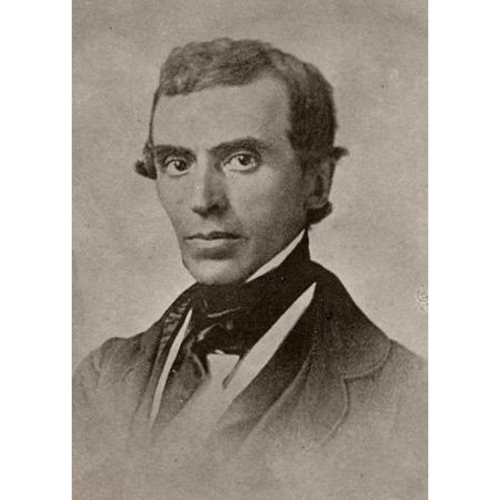
Source: Courtesy of Wikimedia Commons
CASGRAIN, CHARLES-EUSÈBE, lawyer, politician, and office holder; b. 28 Dec. 1800 in Rivière-Ouelle, Lower Canada, son of Pierre Casgrain* and Marie-Marguerite Bonnenfant; m. 26 Oct. 1824 Eliza Anne Baby, daughter of James Baby*, at Quebec, and they had 14 children, among them Henri-Raymond*; d. 29 Feb. 1848 in Montreal and was buried on 9 March at Rivière-Ouelle.
Charles-Eusèbe Casgrain attended the Petit Séminaire de Québec from 1812 till 1816. He then studied at the Séminaire de Nicolet until 1818. Despite delicate health he began articling with Louis Moquin at Quebec in June of the following year and received his lawyer’s commission on 7 May 1824. He practised at Quebec until 1827, when he moved to Rivière-Ouelle.
Following dissolution of the Lower Canadian House of Assembly in September 1830, Casgrain stood as a candidate in Kamouraska. He was elected along with merchant Amable Dionne*. He rarely spoke in the house, from which he was, indeed, usually absent. According to his family, he quickly took a dislike to parliamentary life and stood aloof from Louis-Joseph Papineau*’s party. Consequently he voted against the 92 Resolutions, which set out the assembly’s principal grievances and demands. He was defeated in the 1834 elections.
Casgrain’s lack of interest in political life did not prevent him from sitting on the Special Council, which was established on 10 Feb. 1838 and charged with administering Lower Canada after the rebellion and the suspension of the constitution. The appointment was hardly surprising, since Casgrain had openly opposed the armed uprising in 1837 and had also welcomed into his home officers of the British troops who were on the move between Quebec and Halifax. His partiality probably made him unpopular with the French-speaking élite.
In April 1839 Casgrain was commissioned to receive the oath of allegiance. Seven years later he was made deputy commissioner of public works, an appointment that was obviously connected with his services during the rebellion, and he then went to live in Montreal. One of his major responsibilities as deputy commissioner was to build the shelters at Pointe-Saint-Charles (Montreal) and Grosse Île for Irish immigrants ill with typhus. In November 1847 he caught a chill, and because of his delicate health he did not get over it. He died while still in his forties.
Charles-Eusèbe Casgrain has been described by some authors as a mediocre politician or as an opportunist intent on pleasing the British authorities. By his firmly avowed loyalty to the crown, he, like many of his contemporaries, had enabled the ruling group to legitimate its authority over the society of Lower Canada. Since he had married a woman who came from a family known since the conquest for its loyalty to the British crown, it would have been difficult for him to dissociate himself too openly from the colonial authority. The Mémoires de famille written by his wife many years after his death portrays Casgrain as a victim of the politics of his time whose conduct it was essential to justify to posterity. Despite the defence he remains an obscure figure in the political history of Lower Canada in the first half of the 19th century.
ANQ-Q, CE1-1, 26 oct. 1824; CE3-1, 29 déc. 1800, 9 mars 1848. ASQ, Fichier des anciens. PAC, MG 29, D61: 1548–54, 1557–58, 1560–63; MG 30, D1, 7: 591–94; RG 4, 138: 7737–46; RG 11, A2, 95, 110; A3, 121; RG 68, General index, 1651–1841, 1841–67. F.-J. Audet, “Commissions d’avocats,” BRH, 39: 583; “Les législateurs du Bas-Canada.” Cyclopædia of Canadian biog. (Rose and Charlesworth), 1: 278. Desjardins, Guide parl. H. J. Morgan, Sketches of celebrated Canadians, 354. P.-G. Roy, Les avocats de la région de Québec. [E. A.] Baby, Mme C.-E. Casgrain, Mémoires de famille: l’honorable C.-E. Casgrain (Rivière-Ouelle, Qué., 1891). Chapais, Cours d’ hist. du Canada, 4: 36, 209, 278, 287. Antoine Gérin-Lajoie, Dix ans au Canada, de 1840 à 1850; histoire de l’établissement du gouvernement responsable (Québec, 1888). P.-H. Hudon, Rivière-Ouelle de la Bouteillerie; 3 siècles de vie (Ottawa, 1972). [M.-E. Perreault], Mme E. Croff, Nos ancêtres à l’œuvre à la Rivière-Ouelle (Montréal, 1931).
Cite This Article
Antonio Lechasseur, “CASGRAIN, CHARLES-EUSÈBE,” in Dictionary of Canadian Biography, vol. 7, University of Toronto/Université Laval, 2003–, accessed December 20, 2025, https://www.biographi.ca/en/bio/casgrain_charles_eusebe_7E.html.
The citation above shows the format for footnotes and endnotes according to the Chicago manual of style (16th edition). Information to be used in other citation formats:
| Permalink: | https://www.biographi.ca/en/bio/casgrain_charles_eusebe_7E.html |
| Author of Article: | Antonio Lechasseur |
| Title of Article: | CASGRAIN, CHARLES-EUSÈBE |
| Publication Name: | Dictionary of Canadian Biography, vol. 7 |
| Publisher: | University of Toronto/Université Laval |
| Year of publication: | 1988 |
| Year of revision: | 1988 |
| Access Date: | December 20, 2025 |



